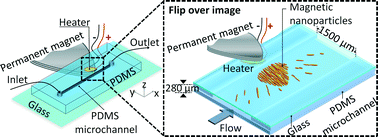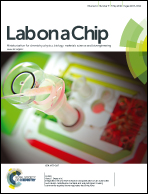Investigation of different nanoparticles for magnetophoretically enabled nanofin heat sinks in microfluidics†
Abstract
Assembled nanofin heat sinks, nanostructures which are formed via external forces in a cooling microfluidic to remove heat from hot spots, are a new concept that has recently been introduced. In this work, we investigate nanofin structures formed by CrO2 and Fe2O3 magnetic nanoparticles and compare their performance. Thermal imaging is used for comparison of three cases including: (i) DI water as the coolant liquid, (ii) suspension of magnetic particles in DI water, and (iii) suspension of magnetic particles in DI water in the presence of a magnetic field. For each case, the experiments are conducted at three different flow rates of 10, 40 and 120 μl min−1. Our results suggest that the high thermal conductivity of the nanofins composed of CrO2 significantly enhances the heat exchange across the microchannel. The proof-of-concept magnetophoretic system can offer a practical solution for the cooling of future compact electronics.


 Please wait while we load your content...
Please wait while we load your content...